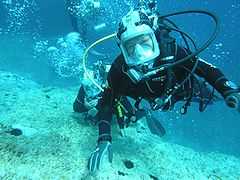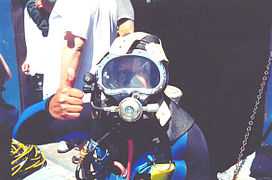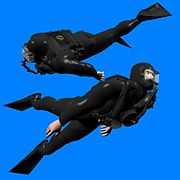Full face diving mask
- For fullface masks on breathing apparatus used out of water, see Self-contained breathing apparatus.
_dive_tank_exhibit_at_the_2005_National_Scout_Jamboree_held_at_Fort_A.P._Hill%2C_Va.jpg)

A full-face diving mask is a type of diving mask that seals the whole of the diver's face from the water and contains a mouthpiece or demand valve that provides the diver with breathing gas.[1] The full face mask has several functions: it lets the diver see clearly underwater, it provides the diver's face with some protection from cold and polluted water, it increases breathing security and provides a space for equipment that lets the diver communicate with the surface support team.
Full face masks can be more secure than breathing from an independent mouthpiece; if the diver becomes unconscious or suffers an oxygen toxicity convulsion, the diver can continue to breathe from the mask unlike a mouthpiece which must be always gripped between the teeth.[1]
Full-face diving masks are often used in professional diving. They are relatively rarely used in recreational diving, where they protect the face from cold water or stings, such as from jellyfish or coral, and prevent the discomfort derived from gripping a mouthpiece between the teeth for long periods.
This type of gear is also sometimes referred to as a Jack Browne rig, named for a Desco engineer who designed an early version of a full-face mask with an integrated air-supply attachment.[2]
Features


Full-face diving mask have these features, with these results:
Straps firmly fasten it to the head
It takes longer to remove the mask when needing to switch to breathing from atmosphere. To avoid this, most full-face masks have a valve to switch between breathing from the set and breathing from atmosphere. That set/air valve should be easily operated by the diver, including if he has thick diving gloves, but not projecting so that it can be easily knocked against things. An excess of bulky projecting valvework may cause water resistance in swimming and moving his head about.
Most full-face masks can be knocked off much less easily than an ordinary scuba mouthpiece or an ordinary eyes-and-nose diving mask; but an excess of bulky projecting valvework may act as a lever for his head to be pushed around by. These risks can happen in these circumstances:
- When working or moving about in zero visibility water or in the dark. This often happens with underwater work, as a work diver cannot choose time and place of diving as easily as a sport diver.
- If he is involved in a hand-to-hand fight underwater. This risk may happen with combat / patrol frogmen in war conditions, or with diving sea-police arresting suspects underwater. In this case, his set/air valve should be where an opponent cannot easily grasp it, either to operate it, or to use it as a handle to pull the mask off or to pull the head about.
- If there is a risk of him becoming unconscious underwater. (For the same reason, many industrial breathing sets and a few scuba set have a mouthpiece with a strap that fastens behind the back of the neck.)
Much less risk of water leaking in past a mouthpiece
Some divers accustomed to open-circuit scuba get into a habit of casually letting small amounts of water leak in between the lips and the mouthpiece and blowing it out the next time the diver exhales. If by force of habit the diver does the same with a rebreather that has a plain mouthpiece instead of a full-face mask, that water will get into the breathing circuit.
Full face mask configurations
Without a mouthpiece inside the full-face mask
Here, the diver can talk clearly without removing his mouthpiece, including talking with other divers underwater. This allows communications equipment (usually an intercom wire or by modulated ultrasound) to be installed in the mask and is very useful for working divers.
If a full-face mask floods underwater, it can be more difficult to clear it, than with a mouthpiece.
There also is the problem of "dead space" inside the mask causing risk of carbon dioxide retention.
With a small mouth-and-nose (oronasal) breathing mask inside the full-face mask
With a small mouth-and-nose (oronasal) breathing mask inside the full-face mask, the dead space is less, and there is less space to needing to be blown empty if the mask floods. But the smaller space around the mouth increases the gas-mask-like distortion of speech.
With a mouthpiece inside the full-face mask
Here, if the mask floods, the diver can breathe again before clearing the mask, and many Royal Navy and frogman's rebreathers have this mask arrangement; but the full-face mask plus mouthpiece combination acts like a strapped-in gag making clear talking difficult but not impossible.
For very many years British armed forces divers have used the Admiralty Pattern full face mask, with a long rectangular window, largely flat, and bent back 90° at the ends, as in the adjacent CGI image of a diver with a CDBA rebreather and in some images at this link. Its lower skirt has a hole that a breathing set mouthpiece is threaded through.
With a removable pod carrying the mouthpiece
Kirby-Morgan makes a unique configuration of full-face mask, the KM-48 Supermask, which has some characteristics of a half mask, while retaining many of the advantages of the full face mask: link.
The rigid plastic main frame of the mask has a rubber skirt which seals around the eyes and nose like a standard half-mask, and the nose may be held through the rubber nose pocket to equalise in the same way as with a half mask, and there is an extension to ths skirt which seals around the lower part of the face and encloses the mouth.
This mask has a clip-on pod section which carries the regulator, and this part seals against the main frame, allowing the diver to remove the regulator pod when on the surface, or to use an alternative gas supply, which can either be mounted on another pod, or be an ordinary Scuba regulator second stage with a standard mouthpiece. This feature makes it possible to use bailout gas supplies by a dive buddy with a standard regulator with the supermask.
An optional pod with a dive/surface valve for use with rebreathers is available to military users: link
Shape of mask window
The fulllface mask's window can be various shapes:-
- Circular, as in wartime Italian frogman's rebreathers and in some early British frogman's rebreathers.
- Oval like a sport eyes-and-nose mask, in some early British frogman's rebreathers.
- Triangular with rounded corners, in some Siebe Gorman fullface masks intended for use with an aqualung.
- Triangular, with sharper corners, in rebreather masks made by DESCO, see http://www.therebreathersite.nl/03_Historical/Desco_B_Lung.htm .
- Some of DESCO's fullface mask windows were egg-shaped (wider above).
- In both these types of DESCO mask the window was very near the face for better sideways and up and down visibility and less deadspace, with a triangular bump-out for the diver's nose.
- Rectangular with the ends of the sides bent back for better sideways visibility, as in the Admiralty Pattern fullface mask made for many years by Siebe Gorman: see Siebe Gorman CDBA.
- Rectangular, continuously curved, for industrial breathing sets for use out of water.
- In some old masks, largely for industrial use out of water, small eye-windows above a rounded opaque nose-and-mouth mask like some gasmasks.
The shape and maximum size of mask and helmet windows changed with availability of transparent materials less brittle and more easily moulded than glass to make them out of: perspex came on the market in 1933 and polycarbonate in 1958. Hardhat diving helmet windows had been of glass for a long time, but a hard helmet screwed to the corselet can carry glass much thicker and stronger and heavier than a mask strapped over the face can.
Breathing tube connections with fullface mask
The breathing tube(s) may connect to the mask in various ways:-
- Through the lower part of the window, as in the Siebe Gorman aqualunger's fullface mask described above.
- Through the mask's skirt at the bottom, as with Siebe Gorman frogman's masks, for example the Siebe Gorman CDBA.
- The early DESCO fullface mask's two breathing tubes entered through the skirt at the sides, level with the lower end of the nose, pointing backwards and a bit downwards, to keep the breathing tubes shorter and not looping about risking catching on things.
-

AGA mask with through-water comms.
-

Military diver with full face mask with through-water comms.
-

Kirby-Morgan band mask.
-

CGI image of 2 divers swimming with CDBA British armed forces rebreathers with Admiralty pattern full face masks
-
Kirby Morgan KM-48 Supermask full face diving mask. Mask and pod split showing mating surfaces
-
KM-48 Supermask assembled view from directly in front
-
KM-48 Supermask assembled view of inside from back
-

KM-48 Supermask assembled, seen from left
-
KM-48 Supermask assembled view from lower front right
-
Draeger Panorama full-face mask with Apeks P-ported demand valve. Upper front view.
-
Draeger Panorama profile view from right side
-
Draeger Panorama inside view from behind.
Other features
The inside of the mask window may get misted/fogged, and need to be treated with a demister. Some British Army and Russian gas masks are designed so that when the wearer breathes in, the inflow of air blows over the inside of the mask window and tends to evaporate any mist deposit on it. This feature is also found on the original Kirby Morgan EXO-26 mask, but the later EXO-BR uses an oro-nasal inner mask to reduce dead space[3]
Bailout arrangements
There are several approaches to bailout air supply which can be used with a full-face mask:
- Bailout gas may be supplied via a bailout block. This is the same system used for diving helmets. The main gas supply to the mask passes through a non-return valve to a bailout block and then to the demand valve. An alternative gas supply is connected to the bailout block through a valve which may be opened by the diver to allow use of the bailout gas. This does not allow supply of bailout gas to another diver. This system is used for most full face masks, as they have no other option.
- For scuba diving with a full face mask, a gas-switching block is sometimes used to supply different gas mixes to the second stage in the mask. A bailout or reserve supply is then available via the switching block and a buddy's block may be connected via an intermediate pressure hose to share gas. This has the advantage that both divers are always breathing the same mixture in an emergency, reducing the chance of one diver inadvertently breathing a mix beyond its maximum operating depth.
- A secondary demand valve can be fitted to some full-face masks. The Draeger Panorama (and the Apeks Panorama) have a port (P-port) on each side which can be used for this purpose. The demand valves of these masks can be unclipped on the surface to allow breathing of atmospheric air, and can also be removed underwater to clip in a secondary supply carried either by the diver of by a buddy carrying compatible equipment. This system also allows for gas switching for decompression if enough of the appropriate demand valves are available.
- The Kirby Morgan 48 Supermask allows the demand valve pod to be unclipped and another clipped on, or a standard demand valve can be used if the pod is left off while it is in use. When this is done the diver inserts the mouthpiece into his mouth in the usual way though the large opening left by the removal of the pod.
Potential problems with full-face masks
The mask window (faceplate) is a high impact strength polymer which is securely attached to the skirt or frame. A failure of the faceplate can be a life-threatening incident with some full face masks, as the water will flood into the oro-nasal inner mask and compromise the air supply. This problem is avoided by the masks which include a mouthpiece.
In the public media
Design of fullface masks (underwater, land, gasmasks) in movies is sometimes constrained by desire to show the actor's face to the camera. There have been cases of fullface masks used in movie filming having a light inside shining on the actor's face so the face shows on camera better: a feature that is no use whatever in practical breathing mask use.
In Fantastic Voyage the diving sequences were filmed using Italian ARO oxygen rebreathers with the mouthpiece (and diving mask) replaced by a pseudo fullface mask not intended to be dived in, because the diving actors were out of water suspended from thin wires.
See also
- Self-contained breathing apparatus: many of them have full-face masks.
- Gas mask: most gas masks are full-face masks.
- Diving helmet.
References
- ↑ 1.0 1.1 Norfleet WT, Hickey DD, Lundgren CE (November 1987). "A comparison of respiratory function in divers breathing with a mouthpiece or a full face mask". Undersea Biomedical Research 14 (6): 503–26. PMID 3120386. Retrieved 2008-08-31.
- ↑ Middleton, JR (1978). "Evaluation of the U.S.N. Lightweight Diving Mask (Jack Browne).". United States Navy Experimental Diving Unit Technical Report. NEDU-14-78. Retrieved 2008-08-31.
- ↑ http://www.kirbymorgan.com/FullFaceMasks/exobr.html
Further reading
- Robinson, M. The Encyclopedia & Guide To Diving With A Full Face Mask, Trafford Publishing, 2012.
| |||||||||||||||||||||||||||||







%2C_is_fitted_with_a_Kirby_Morgan_37_Dive_Helmet.jpg)